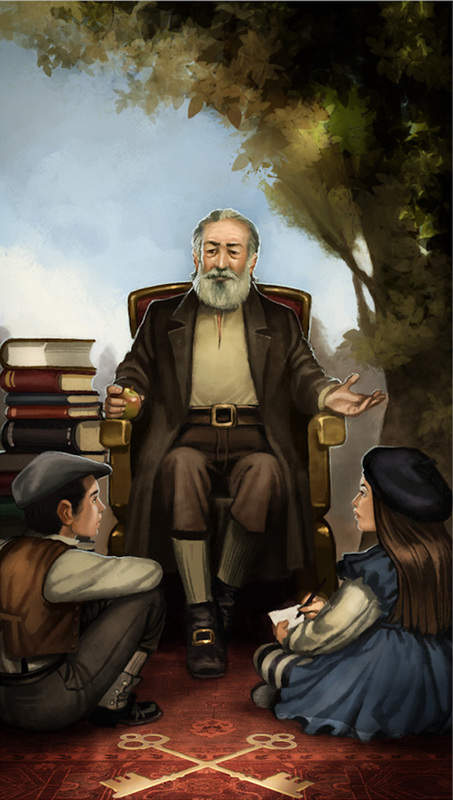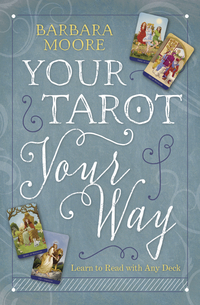|
The Hierophant from the Steampunk Tarot As promised in the previous entry today we are talking about change, specifically facing change with spiritual integrity and authenticity. This essay is brought to you by the number 5.
We’ll begin with the Hierophant, since he is numbered 5 in the Major Arcana. Before we begin, I ask you to open up to the idea that the Hierophant, as other cards in the deck have, can evolve in meaning to better represent our current understanding and world view. In “Tarot, Tricksters, and Accidental Grace” in the Spring 2016 issue of the Cartomancer, I wrote at length about how card meanings change over time and how important it is for us to always look toward reflecting our evolving consciousness as we look at the cards anew. Our beloved Rider-Waite-Smith deck was created in a culture of Victorian Christian mystics and the symbols, images, and ideas represent that culture. That culture is not our culture. Some may argue that spiritual truth or wisdom is absolute and unchanging through time. I do not agree with that and see that as fundamentalism…and to be honest, fundamentalism scares me. In a Hebrew creation story, it is said that God left creation unfinished, allowing it to continue evolving and also invited humans to participate in the co-creation of the future of the universe. I say we take up that invitation and help evolve tarot to better represent what we know to be true for us in this moment, knowing that as human consciousness evolves, the cards meanings will continue to change. Most people have issues with the Hierophant because they see him as the representation of rigid dogma and strict hierarchy. Back in the day when there weren’t many options for spiritual paths circulating in Western culture and when social order was valued very highly, it is true that ordained Church rules were created and used to control people. And sure, we can see that still in play today. However, we…by we I mean tarot readers and spiritual seekers…know now that we do have other options open to us and that maintaining order is not necessarily the main goal of spiritual wisdom. Even in Christianity today, there are some really exciting teachers who are totally pushing the bounds of what Christianity “teachers.” If you are interested, Rob Bell is one of those teachers…whose events are often protested by traditional “Christians.” That alone should be a good reason to be curious about what he is saying. The quickest way to convey my ideas about the Hierophant, which is markedly different from most that I’ve encountered, is to share what I write about him in the companion book for the Steampunk Tarot: 5, The Hierophant “Your every thought, every word, and every action expresses the truth of your soul.” Core meaning: Living faith in every day life. The name of this card comes from the word hierophany and means “the manifestation of the sacred.” Consequently, The Hierophant is one who teaches us how to live in accordance with our sacred beliefs. For those belonging to a group, community, or organized religion, there are usually teachers aplenty. For those who follow a more solitary path, they are often their own hierophant. This responsibility is often supplemented by studying sacred texts, works of art, private spiritual practices, and nature. This card has not always been called The Hierophant. In the oldest of decks, it was titled The Pope, also known as the pontiff. The “pontiff” means “bridge.” He is the bridge between theory and practice. He creates a connection between spiritual belief and daily lives. In this image, he sits between a pile of books, representing the culmination of human spiritual understanding, and a tree, representing many things, including a living practice and the inherent knowledge of good and evil. Both the books and the tree represent roots and tradition, wisdom gained through the ages. The apple, such a mundane symbol, brings to mind many things. Students used to give apples to their teachers. Although not technically correct, many people say that Eve gave Adam an apple, leading to their self-consciousness and banishment from paradise. If you cut an apple crosswise, the center forms a pentagram, representing the four elements of the physical world under the guidance of Spirit. Our hierophant, shown here as a humble, compassionate, and wise teacher, weaves together all these notions, and more, and gives them to us as keys to open up our own understanding. With all teachings, it is up to individuals to take them into their heart and mind and to ultimately decide whether or not to envelop them into their life. When The Hierophant comes to your reading, the most important thing is to ask yourself is how does what you believe match with what you think, say, and do. This card can represent a teacher who will help you identify your beliefs and assist you in determining how to best express those beliefs in your life. Here’s an interesting and key question: how does what you believe match up with what you think, say, and do? How wide is the gap between what you claim to value and your actions in this life? These are the questions the Hierophant gives us. One of the most difficult yet most important times to live our values is when we face changes. It is pretty easy to do what you think is right when things are flowing along all easy and stress free. But what do we do when faced with a challenge brought about by a change in circumstance. If the Major cards represent large, archetypal ideas and important wisdom, the Minors show how those ideas manifest in the physical world. The Hierophant asks “what will you do when faced with [insert any change of circumstance]? The Minor 5s give us scenarios to consider, asking us to face change that challenges our will, shakes our emotions, twists our ideas, or threatens our physical lives. The 5 of Wands shows a natural reaction to having our will questioned: defensiveness and fighting. This shows up often in meetings, where egos (easily associated with will) take over trying to preserve their place in the pecking order. In these cases, our wills have been distracted from their original purpose. Presumably we come to a meeting in order to accomplish a task as a group, everyone on the same team trying to do the best thing. However, when our ideas are not valued as much as we think they should be or as immediately as they should be, we change our focus from accomplishing the goal of making good decisions as a group to preserving our ego. The question we can ask ourselves is: which behavior best expresses our beliefs and values? Is it really serving our spiritual value to preserve some perceived pecking order or is it to help foster a sense of community and do great work together? The 5 of Cups calls into question how we react when faced with the knowledge that emotions and relationships are not permanent. We all know this to be true…emotions and relationships can and do change. Change is a natural part of life. Even in nature, nothing is static. How do react when faced with such a loss, the loss of dear one or even the recognition that we no longer feel the same way about someone or something? What is our guiding spiritual principle in these cases and to what extent to our actions match that principle? The 5 of Swords gives us the opportunity to think about how we react when our ideas about what is true are challenged. Although in the card, we usually think the story is about when others take what is ours or behave unfairly or cruelly and that is one valid way, but for this study we are looking at a different facet. Sometimes we have a beloved mindset that shapes our worldview and that we believe to be true and perhaps even True…unchangeable. Is our spiritual guiding force in these cases to hold true to those ideas no matter what evidence is produced to the contrary? Think of fundamental Christians who cling to the idea that the world is only a few thousand years old. Or of early American people who thought that African Americans should be slaves. Or of people who think that gay people have an agenda to destroy America. Insert your own deeply held idea. How do you react when faced with something that challenges that idea? The 5 of Pentacles, with its very clear depiction of spiritual life (symbolized by the church window) and human suffering asks perhaps the hardest question. What is our relationship with the Divine when life is hard, when we or our loved ones are suffering, when terrible things happen to innocent people? How do we react when things that were good, maybe even great, turn to crap? So for me, the Hierophant is the one who helps us learn to grapple with these important situations, who helps prepare us to understand what it means to live a life of authenticity and integrity, no matter the circumstances. And if you made it to the end of this, thank you for reading.
7 Comments
Seasons of Tarot
Lately I’ve been thinking less about tarot as a divinatory tool and more as a Sacred Text…an unbound book of wisdom. One of the reasons many of us use tarot as a tool of divination is to get advice on the “right” decision regarding choices we have to make. Tarot has proved useful to me and countless others in this capacity. However, my mind has been turning toward the idea of not making a decision because it will give us a particular desired outcome but because it is the right thing to do. These things are not, of course, mutually exclusive, but looking at questions from a different point of view can give us interesting information. Because of this change in focus, the coming weeks and months will bring you a series of essays about Tarot as Sacred Text. The essays will be about my musings and will hopefully inspire you to discover your own unique sacred wisdom within the cards that we all love so well. Summer is winding down. Every change of season brings feelings of endings and new beginnings, of change…sometimes a sense of satisfaction for a season well-spent or regret over missed opportunities. The changing seasons remind us that life is a cycle and this can be comforting, as we know that summer will come ‘round again, that the moon will wax and wane with predictable regularity. They also remind us that time passes and things can never remain the same. The wisdom I’m looking for here in the cards is how we can understand and face change in our lives. The seasons of our lives do not always follow the regularity of the change of seasons. We live for a season, whether a year or a decade or years, as perhaps a student of some particular course of study, as an employee for a company, as a partner to a person. Sooner or later all these seasons end. Sometimes we fight the endings, holding on far too long to what was, comfortable in the familiar, even though we know, deep in our gut or in the center of our heart, that it is time to say good-bye. There are lots of cards of endings in tarot. Death is one card feared by many, a very natural fear as death brings change and humans are generally not fans of change. Actual death can occur in many ways, from a quiet, natural, peaceful death to a sudden, unexpected, and tragic death. However, I think the Death card isn’t necessarily about all forms human death (by human death, I don’t mean only physical death but all the ways humans experience deaths in their lives). Rather, I see it as an organic, natural death, the kind that happens when we see an ending approaching, recognize it, honor it, accept it graciously, and move on to the next phase. We don’t always do that, though. We often, as mentioned earlier, fight it, deny it, clutch tightly to what we think is ours. In those cases, time continues to move on and the experience of death isn’t the easy, peaceful, organic death of the Death card but the sudden, frightening, chaos-creating death of the Tower card. We don’t leave a job we know we should and find ourselves laid off or downsized. We don’t leave a relationship that we know is no longer viable, we don’t end it when we can part as friends who once loved each other but instead end up hurting each other horribly and losing a connection, perhaps forever. Seasons mark beginnings and endings. The Fool card is one filled with the possibility of beginnings. Generally, an optimistic card of beginnings, we are presented with seemingly infinite possibilities. The other aspect of the Fool that we don’t usually acknowledge is that as soon as the Fool takes a step, certain possibilities are no longer available. Beginnings and endings all in one, which is why the Fool can sometimes feel scary. Saying yes to something means saying no to other things. Similarly, the World card, generally an optimistic card of completion (we almost always say “completion” as it sounds more positive than “ending,” which has a sadder feeling to it) also contains a beginning in it. After completing something, it is time to move on…because, as nature teaches us, nothing healthy is stagnant. We’ve achieved something worthwhile and are comfortable with the schedules and systems we’ve created to get there, whether it is a class schedule or a career trajectory. Once the goal is reached, we have to release those comforting routines in order to discover and create the new ones that will take us to our next adventure. Change is an important concept and one we all struggle with. In the next essay, we’ll continue to look at how tarot teaches us about change as we consider the 5s…usually not anyone’s favorite, no matter the suit. And rightly so. The 5s are cards of change. These are just a few of the ways I see the metaphoric idea of seasons in our lives through tarot. I’d love to hear some of your ideas and also if you enjoy reading longer essays such as this. If you listen to Rose Red and Charlie's podcast, Tarot Visions, you have already heard this idea. And you can skip my ramblings and hear it from them firsthand, plus sample readings HERE (or subscribe on iTunes). The idea is to take a show (or probably a movie, book, comic, whatever pop culture thing you love) and make a spread from it using the characters. I think this idea can be super helpful when doing readings for others. One thing we usually want to do is make readings more relatable to whoever we are reading for. TV shows, movies, books, etc. all have elements of story, often with what we may think of as stereotypes but more generously we can think of them as archetypes. So in some ways pop culture is kind of like the mythology of our times. Whatever you think of pop culture, people relate to these stories and the characters living them. What would happen if you asked your querent what is their current favorite show or movie, one that really has grabbed their interest. Ask them to describe the characters from the show that are most intriguing or interesting to them (which may not necessarily be their favorite character), including at least one that they don't like. Then create a spread based on those characters to discover what advice they have about the situation or question. I think it is important to include one(s) they don't like because, as we know, we often dislike something in someone else that we dislike (but don't acknowledge) in ourselves. These parts of ourselves often have something important to say. I've not played with this idea yet but think it has so much potential that I wanted to share it with you...and give a shout out to Rose Red and Charlie. Thanks Rose and Charlie! Love your podcasts! Give Away!I have two advanced copies of my next book, Your Tarot Your Way, to give away. You can read more about it HERE. To enter, leave a comment telling me what TV show, movie, book, comic, etc. you would use to make a spread for yourself. On August 18 (noon CST) I will randomly draw two names. US addresses only. 1-Year Novice Program, September SessionThe next session of the Novice Program begins September 1. There are still a few spots left. Join us for an intense and fulfilling year of tarot! Find out more HERE.
|
Categories
All
Archives
September 2023
|



 RSS Feed
RSS Feed